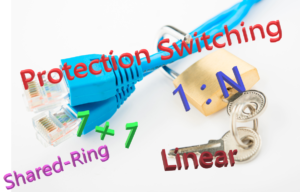This post defines and describes the term head-end for APS (Automatic Protection Switching) applications.
What is the Head-End, within an APS (Automatic Protection Switching) System?
ITU-T G.808 Defines the Head-end as:
The head-end of a protection group is the end where the bridge process is located. If traffic is protected in both directions of transmission, the head-end process is present at every end of the protection group.
NOTE: Whenever people discuss the head-end of an APS system, they sometimes use the alternative term source-node.
ITU-T G.808 Defines the Source-Node as:
The node at the Ingress to a protected domain, where a normal traffic signal may be bridged to the protection transport entity.
So What Does All This Mean?
In Figure 1, we show a drawing of a Protection Group.
If we were to look closely at the Normal Traffic Signal (within Figure 1), we would see that the Head-end is the first component that the Normal Traffic Signal passes through as it enters the Protection Group.

Figure 1, Illustration of a Protection Group
The Head-end (or Source Node) is responsible for connecting the Normal and Extra Traffic Signals to the Working and Protect Transport entities, as appropriate for APS applications.
The Head-end will typically use a Bridge to connect the Normal Traffic signals and the Extra Traffic Signal (if available) to the Working and/or Protect Transport entities.
Automatic Protection Switching typically uses one of two types of Bridges.
- The Permanent Bridge and
- The Broadcast Bridge
We will discuss each of these bridges below.
The Permanent Bridge – (for the 1+1 Protection Switching Architecture)
If you use the 1+1 Protection Switching Architecture, you will typically use the Permanent Bridge.
The Permanent Bridge (as its name implies) permanently bridges (e.g., connects) the Normal Traffic Signal to both the Working and Protect Transport Entities.
Figure 2 presents an illustration of a Permanent Bridge.

Figure 2, Illustration of a Permanent Bridge
This means that, for the 1+1 Protection Switching Architecture, the Working and Protect Transport entities always carry the Normal Traffic Signal.
In this case, the Bridge also acts as a “splitter” that transmits the Normal Traffic signal via the Working Transport entity and a replica of the Normal Traffic signal via the Protect Transport entity.
Figure 3 shows a drawing of a Protection Group that uses the 1+1 Protection Switching Architecture.

Figure 3, Illustration of a Protection Group that uses the 1+1 Protection Switching Architecture
The Broadcast Bridge – (for the 1:1 and 1:n Protection Switching Architecture)
If you are using the 1:1 or 1:n Protection Switching Architecture, you will typically use the Broadcast Bridge.
For the one or n Working Transport entities (for the 1:1 or 1:n protection switching architectures, respectively), the Broadcast Bridge will permanently connect the Normal Traffic Signal to the Working Transport entity.
The Broadcast Bridge will (upon protection-switching controller command or configuration) also connect its corresponding Normal Traffic signal to the Protect Transport Entity.
We discuss the protection-switching controller in another blog post.
The 1:1 or 1:n Protection Switching Architecture may also include an Extra Traffic signal, which travels through the Protect Transport entity whenever none of the Working Transport entities declare service-affecting or signal degrade defect conditions.
Below, Figure 4 presents an illustration of the Broadcast Bridge.

Figure 4, Illustration of a Broadcast Bridge (for 1:1 and 1:n Protection Switching schemes)
Additionally, Figure 5 presents an illustration of a Protection Group that uses the 1:2 Protection Switching Architecture and (thus) uses Broadcast Bridges within its Head-End circuitry.

Figure 5, Illustration of a Protection Group that uses the 1:2 Protection Switching Architecture
Summary
The Head-End (called the “Source Node”) is usually the first component that a Normal Traffic Signal will pass through as it enters a Protection Group.
The Head-End (or Source Node) performs a Bridging Function between the Normal Traffic Signal and the Working and Protect Transport Entities.
We use two basic types of bridging functions in Protection Switching applications.
The Permanent Bridge permanently connects the Normal Traffic signal to the Working and Protect Transport entities.
A Broadcast Bridge permanently connects the Normal Traffic signal to the Working Transport entities.
Finally, the Broadcast Bridge will (upon user command or configuration) also connect the corresponding Normal Traffic signal to the Protect Transport entity.
Has Inflation got You Down? Our Price Discounts Can Help You Beat Inflation and Become an Expert on OTN!! Click on the Banner Below to Learn More!!
Discounts Available for a Short Time!!!

Click on the Image Below to see more Protection-Switching related content on this Blog:

Protection-Switching Related Blog Posts Basic Protection-Switching Terms Head-End (Source Node) Hold-Off Timer Protection-Group Protection-Transport entity Selector Switch Tail-End (Sink Node) ...












